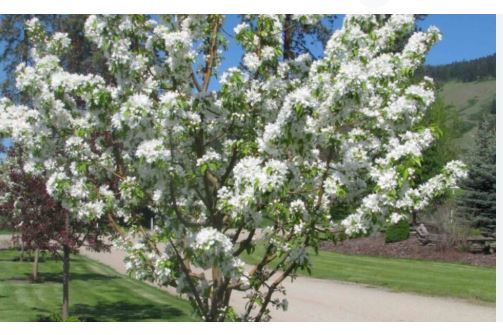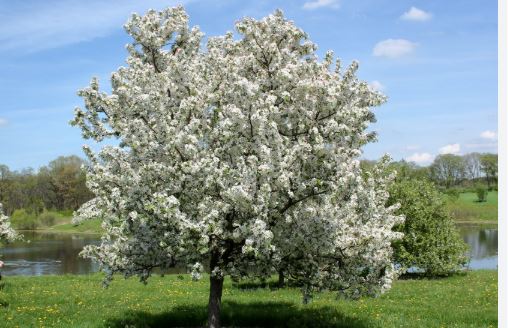
The Adirondack Crabapple (Malus ‘Adirondack’) is a stunning, small deciduous tree prized for its profuse blooms, vibrant fruit, and excellent disease resistance. As a cultivar of the Malus genus within the Rosaceae family, this ornamental tree is a favorite among landscapers and homeowners for its compact form and year-round beauty.
Botanical Classification
The Adirondack Crabapple belongs to the following taxonomic classification:
- Kingdom: Plantae
- Phylum: Tracheophyta
- Class: Magnoliopsida
- Order: Rosales
- Family: Rosaceae
- Genus: Malus
- Cultivar: ‘Adirondack’
The Malus genus includes both apples and crabapples, with the distinction often based on fruit size: fruits smaller than 2 inches in diameter are typically classified as crabapples, while larger fruits are considered apples. The Adirondack Crabapple, developed through selective breeding, is a hybrid cultivar specifically bred for ornamental qualities and disease resistance, making it a standout in the Malus genus.
History

The Adirondack Crabapple was introduced by the United States National Arboretum in 1982 as part of a breeding program aimed at creating disease-resistant, aesthetically pleasing crabapple cultivars. Named after the Adirondack Mountains in New York, this cultivar was selected for its compact, upright form and exceptional floral display, making it a top choice for landscapes with limited space. The breeding program focused on enhancing resistance to common crabapple diseases such as apple scab, fire blight, cedar-apple rust, and powdery mildew, which have historically plagued many Malus species.
Crabapples, in general, trace their origins to the mountainous regions of Central Asia, particularly Kazakhstan, where the ancestor of modern apples, Malus sieversii, is native. The Malus genus spread across the Northern Hemisphere via trade routes like the Silk Road, with cultivation in Europe and North America beginning centuries ago. While crabapples were introduced to North America by European colonists, native species like Malus coronaria (sweet crabapple) and Malus fusca (Pacific crabapple) already thrived in the continent. The Adirondack Crabapple represents a modern advancement in crabapple breeding, combining aesthetic appeal with hardiness and disease resistance.
Native Area
While the Adirondack Crabapple is a cultivated hybrid, its parent species within the Malus genus are native to temperate regions of the Northern Hemisphere, including North America, Europe, and Asia. Specifically, the crabapple’s ancestral roots lie in the mountains of Kazakhstan, where wild Malus species still grow.
Native North American crabapple species, such as Malus coronaria (sweet crabapple) and Malus fusca (Pacific crabapple), are found across a wide range, from the eastern United States to the Pacific Northwest and Alaska. The Adirondack Crabapple, however, is not naturally occurring and was developed in a controlled breeding environment to thrive in various climates, particularly in North America.
Identifying Characteristics
The Adirondack Crabapple is celebrated for its distinct features, making it easy to identify in landscapes and gardens. Here are its key identifying characteristics:
- Size and Shape: This small deciduous tree grows to a height of 12–18 feet with a narrow spread of 6–10 feet, forming a columnar or vase-shaped canopy with predominantly ascending branches. Its compact size and upright form make it ideal for small spaces, formal gardens, or urban landscapes.
- Foliage: The leaves are ovate to elliptic, medium to dark green, and up to 3 inches long with serrated margins. In fall, the foliage turns a subtle yellow, though the fruit display often overshadows the fall color. Some leaves may have slight lobing.
- Flowers: One of the most striking features of the Adirondack Crabapple is its profuse spring bloom. Deep carmine or reddish-pink buds open into large, fragrant, waxy white flowers with pink tinges in late spring (April–May). The flowers, arranged in cymose inflorescences of 5–7 blooms, create a spectacular display, often considered one of the heaviest among crabapple cultivars. The stamens are white with yellow anthers, adding contrast to the petals.
- Fruit: Following the bloom, the tree produces abundant clusters of small, glossy, bronze-red to orange-red pomes (fruits), approximately 0.4–0.6 inches in diameter. These cherry-like fruits persist into early winter (December), providing visual interest and attracting birds. The fruits are edible but tart, often used for jellies or left for wildlife.
- Bark: The bark is typically greyish-brown, smooth when young, and develops vertical cracks or scales with age. It may ooze golden-brown amber when infected, though the Adirondack’s disease resistance minimizes this issue.
- Growth Habit: The tree’s narrow, upright form and dense branching make it suitable for tight spaces, such as along streets or in small yards. Its structure ensures good air circulation, reducing disease risk.
Uses of the Adirondack Crabapple
The Adirondack Crabapple is primarily an ornamental tree, valued for its aesthetic contributions to landscapes. Its uses include:
- Landscaping: The tree’s compact, columnar shape and vibrant seasonal displays make it ideal for small gardens, urban landscapes, courtyards, and street plantings. It serves as an accent tree, shade tree, or specimen tree, adding year-round interest with spring blooms, summer foliage, fall fruit, and winter structure.
- Wildlife Support: The persistent fruits attract birds, such as robins and cedar waxwings, providing a vital food source in late fall and winter. The tree also supports pollinators like bees during its spring bloom and serves as a host plant for butterflies and moths.
- Culinary Uses: While the tart fruits are not typically eaten raw, they can be used to make jellies, preserves, or cider. Their high pectin content makes them excellent for jelly production, a common use for crabapples.
- Medicinal and Traditional Uses: Historically, crabapple fruits and bark have been used in traditional medicine by Indigenous peoples for treating ailments like stomach disorders, skin infections, and pain. While not a primary use for the Adirondack cultivar, its fruits share similar properties.
- Wood: Crabapple wood, including that of the Adirondack, is hard and durable, occasionally used for tool handles or smoking foods due to its pleasant aroma when burned.
- Cultural Significance: Crabapples, including cultivars like Adirondack, hold cultural value in various traditions, symbolizing resilience and beauty. Indigenous groups, such as the Gitga’at and Kwakwaka’wakw, have used crabapples in ceremonies and storytelling, though this applies more to native species like Malus fusca.
USDA Hardiness Zones
The Adirondack Crabapple thrives in USDA Hardiness Zones 4–8, making it suitable for a wide range of climates, from cold northern regions to warmer southern areas. It prefers full sun to maximize flower and fruit production and grows best in well-drained, slightly acidic soils (pH 5.5–6.8), though it tolerates a variety of soil types, including clay, loam, and sandy soils. The tree is also drought-tolerant once established, requiring minimal watering except during prolonged dry periods. Its adaptability to urban conditions, such as pollution and compacted soils, further enhances its versatility.
Fun Fact
The Adirondack Crabapple received the prestigious Award of Garden Merit from the Royal Horticultural Society for its outstanding ornamental qualities and disease resistance. This accolade highlights its reliability and beauty, making it a top choice for gardeners worldwide. Additionally, its compact size and heavy bloom make it one of the most floriferous crabapple cultivars, often described as a “floral fireworks display” in spring.
Care and Maintenance Tips
To ensure the Adirondack Crabapple thrives, follow these care tips:
- Planting: Choose a site with full sun and well-drained soil. Plant in early spring for bare-root trees or anytime for container-grown or balled-and-burlapped stock.
- Pruning: Prune in late winter or early spring before flower buds form to remove crossed branches, water sprouts, or suckers. Minimal pruning is needed due to the tree’s naturally tidy form.
- Watering: Water regularly during the first year to establish roots. Once established, the tree is drought-tolerant but benefits from occasional deep watering during dry spells.
- Fertilization: Apply a balanced fertilizer in early spring to promote healthy growth and flowering.
- Pest and Disease Control: The Adirondack Crabapple is highly resistant to apple scab, fire blight, cedar-apple rust, and powdery mildew, reducing the need for chemical treatments. Monitor for pests like leafhoppers, which may feed on foliage but cause minimal damage.
- Mulching: Apply a 2–3-inch layer of mulch around the base to retain moisture and suppress weeds.
Challenges and Considerations
While the Adirondack Crabapple is low-maintenance, there are a few considerations:
- Slow Establishment: The tree may take time to establish, with slower initial growth compared to other crabapples. Patience is key for optimal development.
- Fruit Drop: Although the small fruits are less messy than larger crabapples, fallen fruit may require cleanup in high-traffic areas.
- Pest Susceptibility: While disease-resistant, the tree may attract leafhoppers or Japanese beetles, though damage is typically minimal.